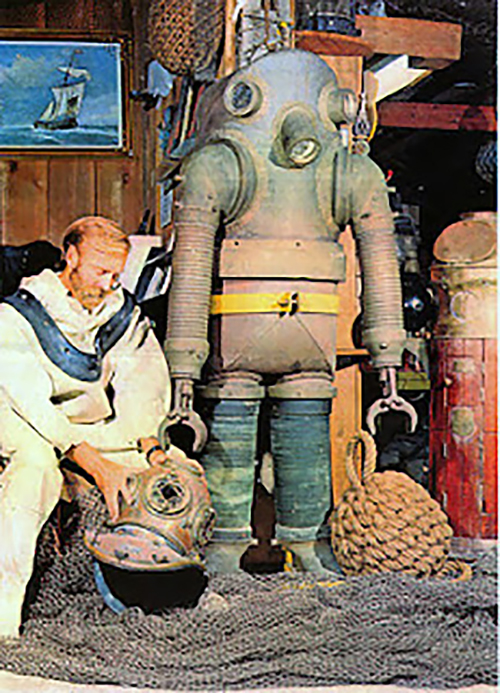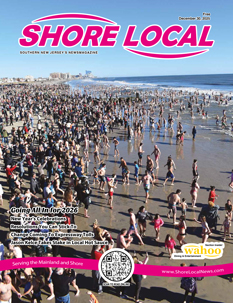By William Kelly
For many years the Smuggler’s Shop on the Ocean City Boardwalk, between 13th and 14th streets, was one of the most popular places to visit for locals and tourists alike.
With a nautical motif, it offered a variety of seashells from all over the world, some from the beach out front, as well as whaler’s harpoons like those portrayed in “Moby Dick,” the backbone of a whale, and the most interesting item – Iron Mike, a pre-scuba era deep sea diving suit like those used in the movie, “Beneath the 12-Mile Reef.”
The only thing more fascinating than Iron Mike was the old salt smuggler himself, Sam McDowell, who certainly looked and lived the part.
Born in 1929 in Somers Point, McDowell worked as an Ocean City lifeguard (1948-’53 and ’58-’59), a period which included a stint in the Air Force. McDowell was a fine artist who worked in various mediums including painting, sculpture and scrimshaw.
During the winter, when the Boardwalk shops were closed, he taught art at Princeton University where in the 1950s he met then Sen. John F. Kennedy collected scrimshaw and admired some of McDowell’s work. Kennedy encouraged him to concentrate on the almost lost art.
Discovering that he could earn more money carving scrimshaw than he could from the Smuggler’s Shop and teaching art, he moved to the West Coast beach community of Carmel, Calif., seasonally spending time in Bequia in the West Indies. In Carmel, McDowell lived as a neighbor and friend of Clint Eastwood, and kept an Ocean City lifeguard surf boat on the beach that he used to take early morning rows.

At Bequia he owned a house on a farm and actually went whale hunting with the natives, who were permitted to continue their tradition of hunting whales for sustenance.
When McDowell donated some of his art to the Ocean City Historical Museum and to the Somers Point Historical Society, he included a painting he did from memory of the Launch Haven trolley stop at Christmas time, I wrote an article about him on my blog, and interviewed him over the phone at the time.
“It’s a great spot to grow up,” said Sam McDowell of Somers Point and Ocean City, where he and his eight sisters and brothers lived, went to school and worked on the beach and Boardwalk. McDowell’s memories of the Jersey Shore are reflected in his art.
“I’ve been very lucky and feel I owe it to the people to tell them how nice it really is,” McDowell said in a telephone conversation from his home in Carmel, Calif.
“I lived in Somers Point, and liked Ocean City very much, the High School, the Beach Patrol – it’s a great spot to grow up, so I wanted to give something back to the community.”
Working as an art teacher in Princeton, McDowell spent summers at his Boardwalk shop from the ’50s through the ’70s, where he worked next to Iron Mike, the antique diving suit, and sold nautical gifts, including scrimshaw carvings on whalebone.
While whale bones are no longer legal tender, he began carving scrimshaw on faux ivory, and became a scrimshaw trader.
“I realized that I could make more money doing scrimshaw than I could teaching or working at the Smuggler’s Shop,” explained McDowell. So putting everything else aside, he concentrated on the bone carvings and is now considered one of the foremost scrimshaw artists in the world.
Not just a rare, contemporary scrimshaw artist, McDowell has actually been whaling, having accompanied some natives from Bequia, where they are permitted to hunt four whales a year, as they have done for centuries.
”I could row, so they let me go along with them,” said McDowell, “and it was scary because they do it exactly like they did it 200 years ago. They throw a harpoon into the whale and hope for the best,” going on what they call a “Nantucket sleigh ride.”
Although his scrimshaw earns the bread and butter, his other artwork is also popular, and prized by collectors. Some of his paintings reflect his early life in Somers Point, including his family’s Sunny Avenue home which is still there.
Having recently made prints of some of his paintings, McDowell gave two of them to each of the local museums, including “Christmas Shopping on the Shore Fast Line,” and “Decoration Day on Bay Avenue.” “Christmas Shopping on the Shore Fast Line” shows people getting off the trolley at the Launch Haven stop in Somers Point, some holding bags from Talese’s tailor shop and Stainton’s Department Store, two iconic businesses from Ocean City past.
Decoration Day, now Memorial Day, has people getting ready for the big parade which ends at the Somers Point beach where they laid wreaths in the water for those who died during wartime.
There’s a schooner sailing on the bay with Ocean City in the background. Accompanying each picture is an essay McDowell wrote explaining what he was trying to convey in the paintings.
Sally Hastings, then president of the Somers Point Historical Society, said “These pictures are really special because they capture a sense of family and community that we would like to preserve. We are very appreciative of all that the McDowell Family has done for us. Although spread across the country, they have remained a close family and always remember their roots growing up here in Somers Point.”
As for Iron Mike, the deep sea diving suit, Steve Garza tracked him down. Sam told Garza that in 1980 he sold Iron Mike to a nautical museum at City Island in the Bronx, N.Y., but Garza learned that today it resides in Islamorada, Fla., at the Florida Keys History of Diving Museum.
Their research discovered that Iron Mike was built in the early 1930s by the Empire Marine Salvage and Engineering Corporation of New York City, which was headed by Thomas P. Connelly. A patent filed in 1934 lists Connelly as the inventor.
The company had an address at 17 Battery Place in New York. But the salvage operations were based across the Hudson River in Jersey City.
Iron Mike’s primary “occupant” was a well-known commercial diver Roy R. Hansen of Perth Amboy.
According to the patent, Iron Mike was designed with a number of innovative features, most of which were significant improvements over standard diving equipment of the times. Iron Mike was fully pressurized and self-contained, with an oxygen tank that provided approximately four hours of air time, which was included within the suit, so no air hoses were necessary, and a bottle of caustic soda would absorb the carbon dioxide emitted by the diver.
A telephone line was attached so the diver could keep in contact with the vessel on the surface. Mechanical “hands” of a permitted him to grasp objects.
The suit consists of a top and bottom pieces, secured together with a threaded ring, which could easily be opened. The buoyancy of the suit made it naturally return to an upright position, a feature the diver could take advantage of to lean over to closely inspect an object, as the suit would upright itself.
Iron Mike undertook three dives that received notable press coverage, and made him something of a celebrity. There were likely other dives, but without the company’s records they can’t be documented. If Iron Mike could speak, he probably would have many fascinating stories to tell.
The Hussar was a British ship carrying pay for their soldiers during the American Revolution. In 1780 The Hussar hit a rock and sank in the Hell Gate, a treacherous waterway in the East River off New York City. Connelly’s company was one of at least three parties that attempted to locate the ship in the mid-1930s.
For this mission, Iron Mike was outfitted with a huge light above its head and one on each arm, and dragged through the water behind a tugboat called The Terminal. Despite the relatively shallow depth of about 120 feet, Hansen called the job one of the nastiest of his career due to the strength of the currents.
The search continued along the shores of the Bronx for about a month, during which Hansen identified six shipwrecks, none of which was The Hussar. The search was then called off because Simon Lake, the inventor of the modern submarine, and Pleasantville, native, claimed to have exclusive rights, granted by the Treasury Department, to recover The Hussar. Lake was ultimately unsuccessful in this effort.
The Merida was a passenger steamer carrying gold and silver bullion from Mexico in 1911 that collided with another ship and sank off the Virginia coast in about 270 feet of water.
Connelly and company dove the wreck with Iron Mike in August 1936, and according to some reports, they did salvage some of the cargo, but no details were provided. The cargo had an estimated value of $26 million in 1936 dollars, or about $425 million today.
A New York Times article about the expedition reveals some interesting insights about the mission and Iron Mike. Roy Hansen, by this point very experienced using Iron Mike, was supremely confident in the suit and the chances of success on this mission.
Shortly after The Merida dive, Iron Mike was used to recover the body of a 13-year-old boy who drowned in a flooded quarry in Pennsylvania.
It is not clear what became of Thomas Connelly and his company, or when Iron Mike was retired from commercial diving. Iron Mike was reportedly stored at the Philadelphia Naval Ship Yard at some point in the 1940s, and after that was part of a live diving demonstration in Atlantic City, probably at Steel Pier.
From there he was acquired by Sam McDowell and spent his years in Ocean City. Around the time Sam closed the Smuggler’s Shop, around 1980, he sold Iron Mike to the Northwind Undersea Institute in City Island, Bronx, N.Y., a museum co-founded by folk singer Richie Havens.
From there Iron Mike was acquired by Drs. Joe and Sally Bauer, the founders of the Florida Keys History of Diving Museum in Islamorada, Fla., and the museum has been his home ever since.
Some time before he got to the museum, his upper body was painted yellow for an unknown reason. The museum is interested in restoring him to his original finish, but does not have the resources to do so at this time.
After reading my article on his art donations to the Somers Point Historical Society, Sam sent me a gift, one of his classic scrimshaw carvings of a whale on a pen knife.
I recently learned that Sam McDowell passed away in his late 80s a few years ago, though I couldn’t find an obituary. He most certainly was one of the most interesting characters I’ve known.










